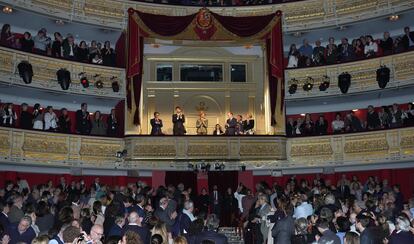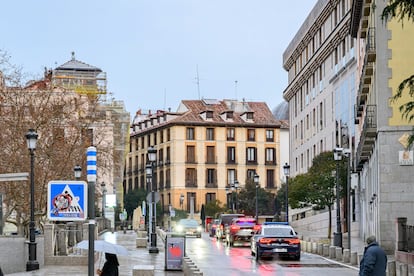They were born to touch each other and have done so ever since as a necessary ritual to stay alive. In this century, its strings have been caressed thanks to the chamber music cycles that National Heritage organizes in the columned hall of the Royal Palace of Madrid. There, a few meters from the showcases that host them the rest of the year, the palatine quartet of stradivarius of National Heritage, the work of the most famous luthier in history, offer their unique sound to about three hundred people, four days a year. This Monday they left their residence – guarded by the National Police and with a strict security protocol for their handling – for the first time since 1996, so that the Cuarteto Casals, pioneer of music of this type of groups in Spain and internationally recognized For more than two decades, he has been playing his tuning forks, only now in front of almost 2,000 people and in a solidarity concert at the Teatro Real in Madrid for the “recovery of the musical and cultural fabric” of the territories affected by last year’s dana in the Valencian Community.
The brilliance of the instruments sounded on the stage of the Madrid colossus with a version for strings of The art of escapethe last work – unfinished – by the master of counterpoint, Johann Sebastian Bach, at times distracting the gaze from the instruments and giving the sound the true prominence. Listening to them, according to María José Suárez, curator of National Heritage and in charge of the care of the Palatine Quartet, “is the maximum expression of the sublime.” Their eyes, unlike those of the public, do not take any license and, blinking just enough, do not separate themselves from the works of art they are watching.
“I have a lot of responsibility,” the curator justified hours before the concert, in the bowels of the Real, without taking her eyes off the dressing room from which she had been taken away, almost by force, to chat with the press. The anxiety that the closed door caused him was evident. So much so that he could not avoid, even on a couple of occasions, abandoning the conversation to establish order and repress those who entered, almost without asking, the space guarded by a security guard. “Excuse me, but there are a lot of people coming in,” she said, annoyed. The four jewels of National Heritage had arrived at that small circular space, adjacent to the stage, crossing the Plaza de Oriente that separates the Palace from the Theater, escorted by four National Police cars. “It is a security protocol that involves many work areas and an entire itinerary to follow, a combination of various teams and joint work between Heritage and the Teatro Real,” explained Suárez, with the sounds of the strings in the background.
The Casals Quartet—Vera Martínez and Abel Tomàs with the violins, Cristina Cordero with the viola and Arnau Tomàs with the cello—rehearsed, for the first and only time with the stradivariusthe fugues and canons that would play a few hours later. “They are extraordinary professionals and need very little time to understand the instruments,” said Suárez. In the hands of Spanish musicians, the creations of Antonio Stradivari (Stradivarius in Latin) seemed safer than anywhere else. It was hard to imagine that they could do any kind of harm to them, but the protocol is strict: no one puts them under their arm, no one wears earrings or pendants and no one takes unnecessary steps with them. Any movement other than the usual one when playing an instrument must be approved by Suárez.
“They are calmer than normal, they have made it very easy for us,” said violinist Vera Martínez moments before the rehearsal. His hands have touched, like those of the rest of the group—except for Cordero, a recent addition to the group, replacing Jonathan Brown—the National Heritage jewels 18 times. But the “emblematic” stage in which they rehearsed broke the custom. “This is a special concert because many things come together: they let the instruments out of the palace, in a union of National Heritage with the Teatro Real to raise funds for the victims, and the Casals Quartet plays Bach’s work, which is a cathedral. “So many things together rarely happen,” Martínez continued.
They chose for the night the German’s last composition, which he left unfinished. For Martínez, “a reference in history, absolutely magnificent, with a splendid spiritual, technical and composer component.” A work that Bach wrote, as an example of the mastery of counterpoint, for four voices, without specifying the instrumentation. “The work plays a lot with harmonic frequencies and these instruments are ideal for it, because they have a special communication between them and the resonances are very alive because they have known each other for a long time,” said the violinist.

The demonstration of his words would be seen at night, guards and protocols away, or at least hidden. “Once on stage, we enter concert mode and the instruments are as if they were ours,” Martínez assured. And so the four entered, with the stradivarius held by the neck, briefly presented to the public, with its decoration with a border of rhombuses and ivory circles on an ebony paste, and its Renaissance scrolls with plant and flower motifs: also the work of the Italian luthier, and a particular feature of the Palatine Quartet of Heritage National. An event chaired by Queen Sofía and with the presence of the Minister of Culture, Ernest Urtasun; and those of Territorial Policy and Equality, respectively, Ángel Víctor Torres and Ana Redondo; the mayor of Madrid, José Luis Martínez Almeida, and mayors of some of the areas most affected by the catastrophe (Bugarra, Cheste, Calles…).
Once the silence was broken, the music did not stop for almost an hour and a half. Fourteen fugues, four canons in D minor, the conversation of four brothers that resists time. And the final applause that for a couple of seconds refused to close the night. Could the concert have been done in Valencia? The restorer answers yes, but that would have required “a much more complex protocol than moving the instruments 500 meters.” Furthermore, he concludes, at Real there were “many Valencians and the solidarity of all of Spain.” Those 500 meters that they have traveled again this morning, cleaned and relaxed, back to the showcases where they will await, amidst the gaze of hundreds of daily visitors, their next awakening.

